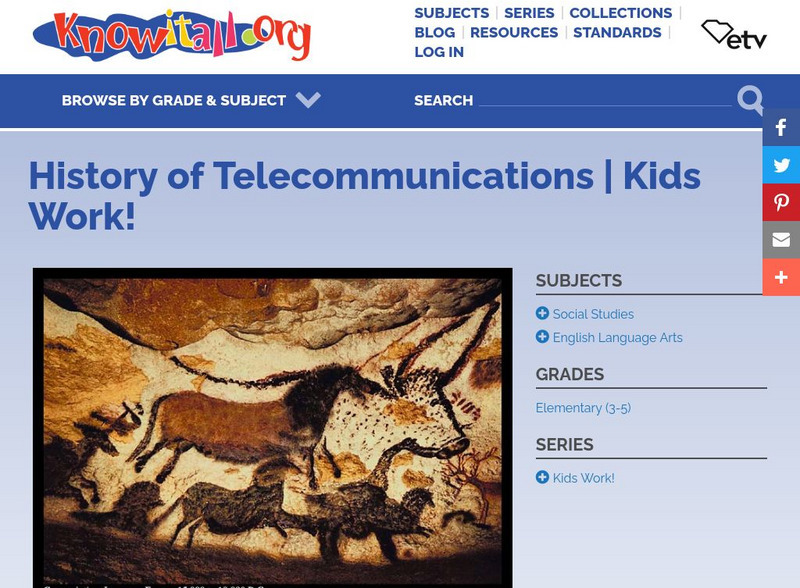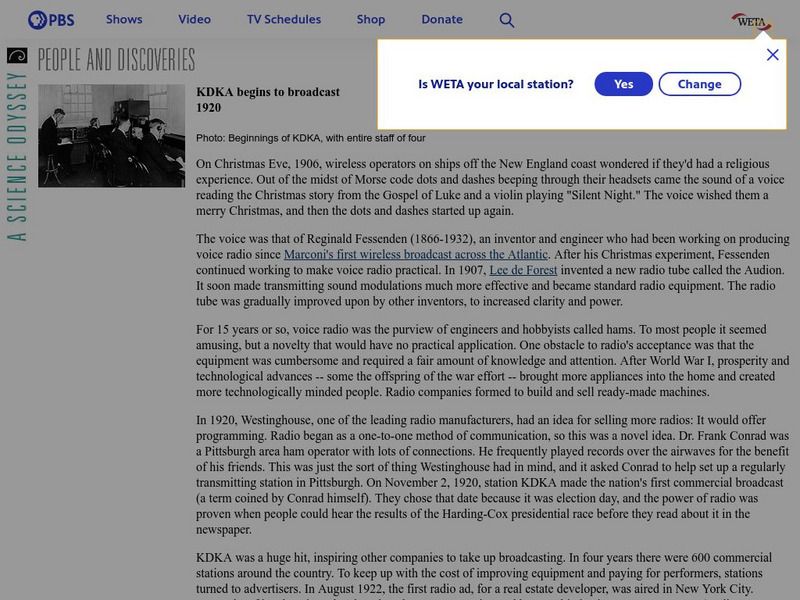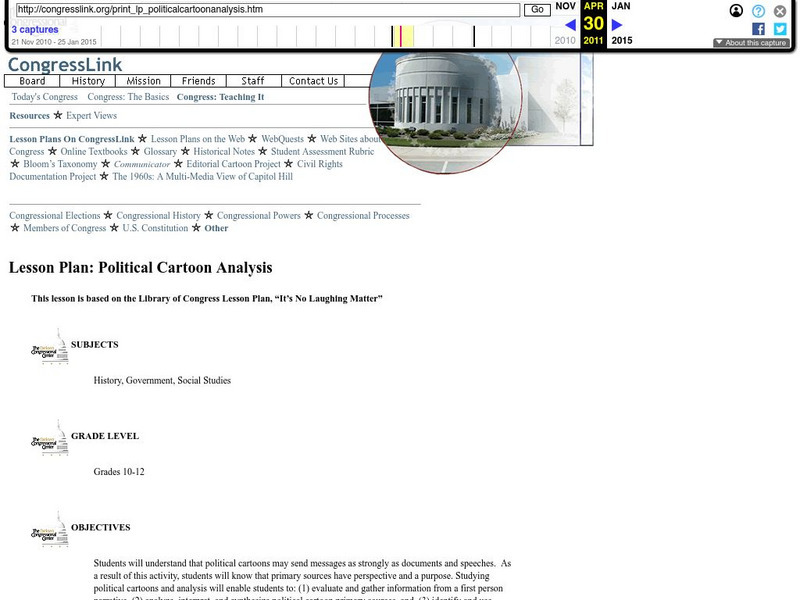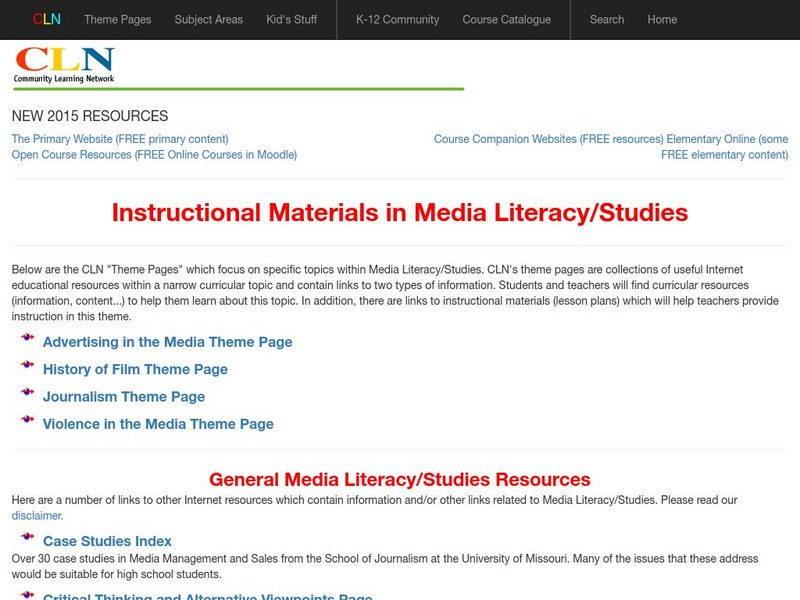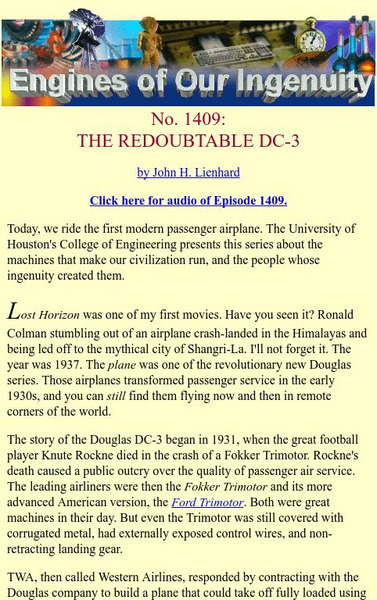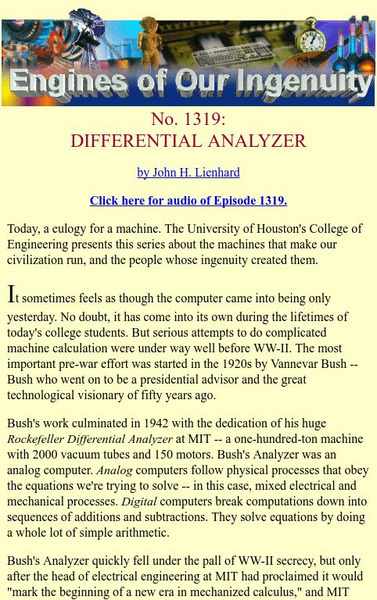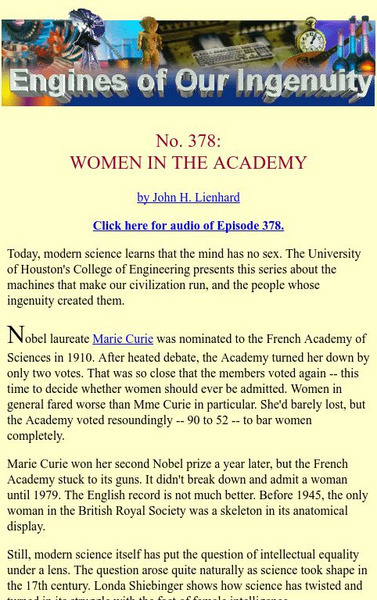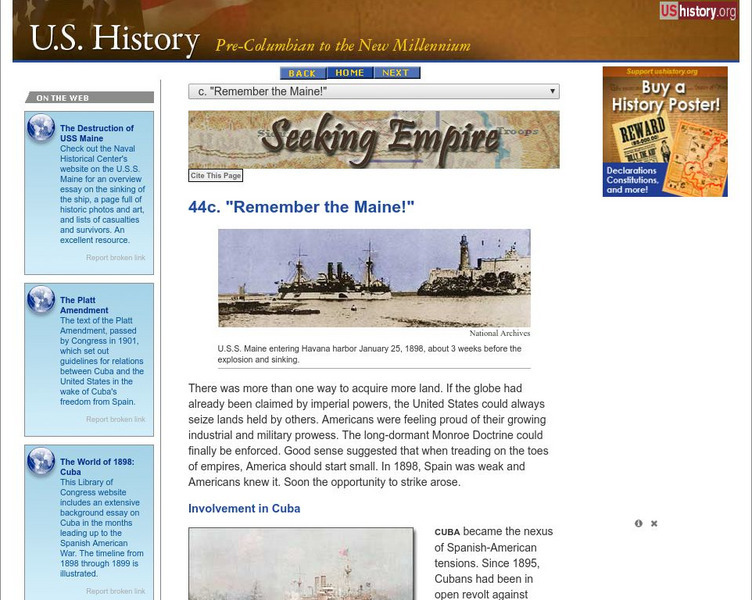Hi, what do you want to do?
South Carolina Educational Television
Kids Work!: History of Telecommunications
An in-depth look at inventions and developments that had an impact on telecommunication.
A&E Television
History.com: 8 Moments When Radio Helped Bring Americans Together
These are just a few of the historic radio broadcasts that seemed to have the whole nation listening. This article discusses eight of the most seminal moments in radio -- from KDKA's 's live nighttime Fireside Chats, the 'Fight of the...
OpenStax
Open Stax: Foreign Policy 1890 1914: Spanish American War and Overseas Empire
Looks at the development and evolution of the Spanish-American War, at Americans' views on imperialism at the end of this war, and at the relationship of this war with America's other international interests.
PBS
Pbs: People and Discoveries: Kdka Begins to Broadcast 1920
This site from PBS details the history of radio and KDKA (Pittsburgh, Pennsylvania) the first radio station to offer programming. Mentions: advertising, NBC Radio, mass culture.
Other
Dirksen Congressional Center: Political Cartoon Analysis
This lesson, designed for students in grades 10-12, will develop an understanding of the messages that political cartoons communicate with readers. They will examine political cartoon primary sources as they investigate the question,...
Community Learning Network
Cln: Instructional Materials in Media Literacy Studies
CLN "Theme Pages," focus on specific topics within Media Literacy/Studies. CLN's theme pages are collections of useful Internet educational resources within a narrow curricular topic and contain links to two types of information....
University of Houston
University of Houston: Engines of Our Ingenuity: No. 1393: Inventing the Telegraph
Read about the history of the telegraph in this article, which is a transcript of a radio broadcast.
University of Houston
University of Houston: Engines of Our Ingenuity: No. 508: Ferris's Wheel
Learn about the history of the Ferris wheel in this transcript of a radio broadcast.
University of Houston
University of Houston: Engines of Our Ingenuity: No. 1373: Pittsburgh in 1816
Pittsburgh had a unique place in the nation after the War of 1812. It was an inland city and a rich source of iron. As such, it needed access to water for transport, and some of the first steamboats were used here. Read more about...
University of Houston
University of Houston: Engines of Our Ingenuity: No. 1342: Wright and Langley
Read about the controversy that emerged over the authenticity of Samuel Pierpoint Langley's flying machine, and the response of the Wright Brothers to attempts to usurp their place in history. This is a transcript of a radio broadcast.
Smithsonian Institution
National Postal Museum: Art of the Stamp: Harriet Quimby
View the artwork for a U.S. postage stamp issued in 1991 to commemorate Harriet Quimby, the first woman ever to earn a pilot's license in the U.S. With a short passage on her accomplishments in both aviation and journalism.
University of Houston
University of Houston: Engines of Our Ingenuity: No. 1409: The Redoubtable Dc 3
Read about the success of the DC-3 passenger plane, which went into use in 1936, in overcoming the difficulties such planes had encountered up until then. This is a transcript of a radio broadcast.
University of Houston
University of Houston: Engines of Our Ingenuity: No. 1319: Differential Analyzer
Read about the work of Vannevar Bush, who invented the differential analyzer, an analog computer. This is a transcript of a radio broadcast.
University of Houston
University of Houston: Engines of Our Ingenuity: No. 283: Aeronautics: 1869
Learn about the first efforts to build a flying machine in this discussion of a Harper's magazine article from 1869 in this transcript of a radio broadcast.
University of Houston
University of Houston: Engines of Our Ingenuity: No. 378: Women in the Academy
Read about the struggles of scientific women to become recognized as the intellectual equals of men. This is a transcript of a radio broadcast.
University of Houston
University of Houston: Engines of Our Ingenuity: No. 423: Terman and Silicon Valley
Read about Frederick Terman, a Stanford University professor, who was largely responsible for the growth of Silicon Valley in California. This is a transcript of a radio broadcast.
University of Houston
University of Houston: Engines of Our Ingenuity: No. 1418: The Influence of War
Does war inevitably advance the invention of new technology? Read this explanation of why this commonly held belief may not be true, at least in the example of military aircraft. This is a transcript of a radio broadcast.
Ibis Communications
Eyewitness to History: London Celebrates Ve Day, 1945
Read the description of the celebrations in London on V-E Day in May, 1945. In addition, listen to the radio broadcast of the surrender of Germay.
Boston College
Becker Collections: Drawings of the American Civil War
The Becker Collection showcases the drawings and observations of artist-reporters who worked for "Frank Leslie's Illustrated Weekly Newspaper," a newspaper of the time. Find a visual record of the war along with other drawings that...
University of Houston
University of Houston: Engines of Our Ingenuity: Count Rumford
A transcript, from a syndicated radio broadcast, that discusses the life and scientific accomplishments of Count Rumford. An anecdotal account of Rumford's contribution to our understanding of heat. Contains a good deal of biographical...
Independence Hall Association
U.s. History: "Remember the Maine!"
See how yellow journalism that reported on the mistreatment of Cuban rebels by the Spanish helped to push the United States into war. Read about the sinking of the USS Maine and the beginning of the Spanish-American War.
PBS
Wnet: Thirteen: African American Lives 2006
From the companion website of the first African American Lives PBS series. (A sequel to that series was broadcast n 2008.) The series profiles the family roots of nine Americans of African descent. Learn what the science of DNA can tell...
Other
Freedom Forum: Lesson Plans for the First Amendment
These lessons address constitutional principles and contemporary issues involving the First Amendment. They intend to have explore how freedoms began and how they operate in today's world. Students will discuss just how far individual...
Stanford University
Stanford University: Early American Newspapers
This site from the Stanford University has an excellent listing of late 1700, early 1800 newspapers that were on the East Coast, and in the South.





